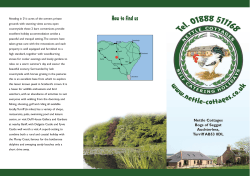
- Outdoor Connection
CONNECTION Instructions Premier Two Burner Stove (GS.14) IMPORTANT: READ THESE INSTRUCTIONS FOR USE CAREFULLY. FAMILIARISE YOURSELF WITH THE APPLIANCE BEFORE CONNECTING IT TO ITS GAS CONTAINER. KEEP THESE INSTRUCTIONS FOR FUTURE REFERENCE. Please Note: This appliance is to be used with a Gas Cylinder with male 3/8 L.H. BSP Fitting.This High Pressure Regulated appliance must only be used with the supplied hose and regulator or an Outdoor Connection genuine spare part (1m hose & regulator assembly GHR.01 and 1.5m hose & regulator assembly - GHR.02) IMPORTANT: - DO NOT MODIFY THIS APPLIANCE. - This appliance shall only be used with propane gas (LPG) in a refillable gas cylinder container certified to AS 2469 – 1999. - IT MAY BE HAZARDOUS TO ATTEMPT TO FIT OTHER TYPES OF GAS CONTAINERS. WARNING: 1. ONLY USE IN WELL-VENTILATED AREAS 2. CARBON MONOXIDE HAZARD – USING THIS APPLIANCE IN AN ENCLOSED SPACE MAY CAUSE DEATH. DO NOT USE IN CARAVANS, TENTS, MARINE CRAFT, CARS, MOBILE HOMES OR SIMILAR LOCATIONS. 3. DO NOT use this appliance if it has damaged or worn seals. 4. DO NOT use this appliance if it is leaking, damaged, or does not operate properly. 5. DO NOT use this stove as a space heater in any way. 6. DO NOT place hands or other body parts over the burners during lighting or during use. 7. DO NOT leave stove unattended whilst in use. 8. DO NOT move stove whilst in use. 9. DO NOT travel with stove connected to cylinder in any capacity. 10. KEEP AWAY FROM FLAMMABLE MATERIALS. 11. A distance of 700mm Overhead and 200mm from the side and 200mm from the rear should be the minimum distance that anything is kept whilst the appliance is running. 12. Only use the hose assembly supplied with the appliance for direct connection to the cylinder – DO NOT USE ADAPTORS. 13. Should the hose be damaged only use a replacement hose that is specified for this appliance. The maximum length that can be used on this appliance is 1500mm. 14. If there is a leak on your appliance (smell of gas), immediately attempt to turn off the cylinder valve. Remove the appliance to a well ventilated location away from any ignition source. Only check for leaks using soapy water. DO NOT TRY TO DETECT LEAKS USING A FLAME. Stove Parts OPERATING INSTRUCTIONS: 1. Remove any packing material before use. 2. Ensure that cylinder valve/tap and stove taps are completely turned off. 3. Check that the seals between the appliance and the gas cylinder container are in place and in good condition before connecting the gas cylinder container. 4. Check that no foreign matter has fallen in under the trivet since/from previous use. 5. Select a flat, level, and sturdy work surface allowing sufficient distance from other objects to place the stove and cylinder on before use. 6. Avoid twisting or kinking the flexible hose 7. Before use make sure you understand the meaning of the symbols on the control knobs. For ignition of the Piezo igniter - to operate, push the red button at the front of the stove. Turn the gas control knob anti-clockwise, as indicated on the front of the knob, to open up gas flow to the burner, and in a clockwise direction to reduce the flame and turn off the stove. 8. Open the lid and windbreaks and secure in a vertical position. 9. Connect stove hose and regulator assembly to the cylinder ensuring that the fitting is tightened firmly. Connect the hose to the stove’s gas inlet and tighten firmly. Ensure that the stove is in a stable horizontal position and the cylinder is in the vertical position. Ensure the valves on the stove are closed and turn on the gas at the cylinder and check connections with soapy water to check for leaks. 10. Turn on the gas using the desired burner control knob and simultaneously push the red Piezo ignition button, being careful not to place any part of your body over the burner. If the burner has not caught alight within several pushes of the Piezo button turn the gas off and allow ay gas build up to escape. Repeat until the burner has caught alight. 11. You can also light the stove with a longer match or BBQ lighter. Open the gas control valve approx. half a turn and hold a match over the edge of the burner until it lights, being careful not to place any part of your body over the burner. 12. By using the burner tap adjust the flame to the desired heat. 13. Whilst the stove is in use, DO NOT MOVE either the stove or the cylinder. TURNING OFF: 1. After use, turn the gas cylinder valve off, wait for the flame to go out then turn the appliance control valve(s) off. The gas should always be turned off at the cylinder first and should not be left open when the stove is not in use. Failure to do this may result in the gas converting back into a liquid in the hose and causing a large flame at the stove when next used. 2. When packing the stove after use, allow sufficient time for the stove to cool down, disconnect the hose from the stove and cylinder. NEVER leave the stove connected to the cylinder when not in use. n n GAS CONSUMPTION: 1. This appliance has a nominal gas consumption of 200g/h for each burner. 2. The jet size is .38mm and is marked “38 “ CARE AND MAINTENANCE: 1. This appliance must only be serviced by an authorised person. 2. To help with the general maintenance of your stove, it should be checked at least every 12 mths for any damage or wear. Look for any damage to the jets, O rings, threads or any part of the stove and hose. If any wear or damage is found replace the part or have it checked by an authorised person. 3. Spare parts for this appliance can be obtained from the place of purchase or any good camping and outdoor outlet. Alternatively contact the importer: Outdoor Connection P.O. Box 506 Sumner Park Qld. 4074 sales@outdoorconnection.com.au 4. Supervise children closely near gas stoves. Parts of the stove can become very hot in use as well as the liquids etc. being cooked. 5. Care should be taken not to obstruct the air openings on the sides of the burner. Obstruction of these holes will result in the stove not operating correctly. 6. Wasps, spiders and other insects like to build nests in the burner tube and gas inlet which can interrupt the gas flow. Check for any signs before use and when not using the stove, keep stored in its box in a dry and clean place. 7. When not in use gas cylinders must be stored outdoors in a well ventilated area out of the reach of children and direct sunlight. Any indoor storage shall comply with AS1596. 8. When changing the gas cylinder, it must be done in a well ventilated area, outside, away from people and from ignition sources such as naked flame pilot flame electrical heaters/equipment. 9. To check whether or not the gas cylinder container is empty, there will be a net weight listed on the side of the collar, anything above that weight will indicate there is still gas inside the cylinder. If uncertain, take back to the place of purchase or to an authorised dealer who will be able to inspect for you. 10. Keep the gas inlet and hose ends clean and free from dirt and grit. The gas jet has a very fine hole and it can be easily blocked. 11. Keep a spare packet of jets handy at all times. 12. You should not use a pricker or needle to clean the jet as this can make the hole larger and adversely affect the performance of the stove. 13. It is best to replace the jet however if a spare is not held you can attempt to clean it by soaking it in some solvent such as petrol (allow it to dry before replacing). This may sometimes dislodge the blockage. 14. The high pressure regulator supplied with this appliance is a sealed unit and must not be adjusted, modified or repaired. If damaged replace the hose and regulator assembly with an Outdoor Connection spare part GHR.01 (1m hose & regulator assembly) or GHR.02 (1.5m hose & regulator assembly). Trouble Shooting Problem The stove will not light A very large flame from the burners Possible fault or action - Check that there is gas in the cylinder and the cylinder valve is turned on - Check that there is nothing blocking the stove gas inlet or hose inlet and outlet - Check that nothing is blocking the air ports in the burner tube - If gas is not coming out of the burner the jet may be blocked. Replace the jet. If the stove is not turned off correctly and the cylinder valve is left on gas can condensate into its liquid form in the hose. When next used the LPG comes through the burner as a liquid and creates the very large flame. Turn off the Stove valve then the Cylinder valve. In a well ventilated area with no ignition sources turn the stove valve back on without lighting the burner and allow the gas in the hose to dissipate. When the small amount of gas has dispersed the stove can be lit as normal. The flaring of the flame from The burner tube may be partially blocked. Remove the burner tube and clean with a the top of the stove with a pipe cleaner and make sure that none of the ports are blocked. yellow flame - The gas cylinder may be nearly empty. Check the cylinder Unable to keep the flame alight or the stove has a very low flame - Check burner tube for blockages - The jet may be partially blocked. Replace the jet. - Check that the connections have been tightened correctly Unable to create a seal at the hose connection to the stove or - Inspect and replace worn O rings on the hose ends the cylinder If the above remedies are not successful, have the stove checked by an authorised person. To replace the jet 1. Disconnect gas cylinder 2. Remove the trivet from the top of the stove 3. Unscrew the drip tray 4. Unscrew the burners from underneath the stove 5. Remove Piezo ignition cords from the electrode attached to the burner 6. Remove the drip tray and burners 7. The jet is screwed into the brass fitting behind the tap. Using a small spanner remove the blocked jet 8. Using the correct size replace the jet and screw it firmly 9. Replace Piezo cords 10. Replace burners and drip tray (make sure that the burners are in the correct position over the jets) 11. Replace trivet
© Copyright 2025









